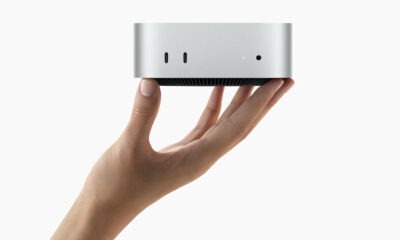Technology
Samsung announces the Galaxy S10e, S10, and S10+

Samsung announces its new lineup of Galaxy S10 smartphones, including the 6.1-inch Galaxy S10 ($899) and the 6.4-inch S10+ ($999).
The company highlighted its “Infinity O-Display” which optimizes brightness levels, shows less blue light and displays over 16 million colors.
The camera has new bells and whistles too, like improved zoom and an ultra wide lens that allows for ground-to-sky panoramic shots. Plus, it offers new lighting and blurring effects.
The Galaxy S10 series is available for pre-purchase starting tomorrow, with orders expected to ship March 8. Here’s what you need to know.
Design
Samsung announced not one phone today, but three: The Galaxy S10, the Galaxy S10+, and a low-end variant dubbed the Galaxy S10e. (That’s not counting a 5G-compatible Galaxy S10 that’ll come at a later date.) The internals aren’t quite the same across the board, but in terms of aesthetics, they’re cut from the same cloth.
The Galaxy S10 series shares much in common outwardly with as does the and S10+’s, down to the Aluminum 7000 series (or ceramic) frames and bezel-to-bezel screens. They feature protective glass — Corning’s Gorilla Glass 6, to be exact — that’s extraordinarily light and thin, but not at the expense of durability. They’re IP68 rated to withstand exposure to water 1.5 meters deep for up to half an hour, and Corning claims the display glass can withstand up to 15 consecutive drops from 1 meter onto rough surfaces and that it’s two times stronger than the S9 series’ Gorilla Glass 5. (The Galaxy S10e makes do with said Gorilla Glass 5.)
The S10 series’ top and bottom bezels of the are a tad narrower than last time around, and that’s not all that’s changed — Samsung has done away with the iris scanner, a hallmark of the Galaxy S and Note series since 2016. (An ambient light sensor and earpiece speaker take its place.) Perhaps more noticeable is the roughly 6-millimeter hole-shaped cutout in the top-right corner, machined precisely to accommodate the front-facing camera. Samsung calls the design “Infinity-O,” and it first made its debut on Samsung’s midrange Galaxy A8 series phones, which launched in January. On the S10 and S10e, the hole-punch cutout is a perfect circle — both phones sport single selfie cameras. But it’s elongated in the case of the S10+ to make way for that phone’s dual-camera shooter.
Here’s how the display sizes and resolutions break down:
- Galaxy S10e: 5.8 inches, 3040 x 1440 pixels (522 ppi)
- Galaxy S10: 6.1 inches, 3040 by 1440 pixels (550 ppi)
- Galaxy S10+: 6.4 inches, 2280 by 1080 pixels (438 ppi)
The Galaxy S10’s HDR-compatible, Super AMOLED screen is a tad taller than that of the S9, which measures 5.8 inches diagonally — the result of the 19:9 aspect ratio (compared with the Galaxy S9’s and S9+’s 18.5:9). It’s almost immeasurably blurrier at about 522 pixels per inch (compared with the S9’s 570 PPI) despite a slight bump in resolution to 3040 by 1440 pixels (versus 2960 by 1440 pixels). And unlike the Galaxy S10e’s display, which is perfectly flat, the Galaxy S10’s curves around the lips of either edge, as does the and S10+’s.

Above: The Samsung Galaxy S10 (on the left) and S10e (on the right).Image Credit: Samsung
In yet another first for the Galaxy S series, the Galaxy S10 and S10+ have an electrostatic fingerprint sensor embedded beneath their display glass. (The S10e, which lacks an electrostatic sensor, has a sleep/wake key with a capacitive scanner.) They work as you’d expect: placing a digit on top of the highlighted portion of the screen unlocks the phone. But the tech is said to be faster than the optical fingerprint sensors in competitors like the OnePlus 6T, Vivo Nex, Xiaomi Mi 8 Explorer Edition, and more secure to boot.
You’ll find a triple-sensor camera module and LED flash around the back of the S10 and S10+ — Samsung’s answer to similar setups in LG’s V40 and Huawei’s Mate 20 Pro — and a dual-sensor camera on the rear of the S10e. As for the handsets’ bottom portions, a USB Type-C port, a microphone, 3.5mm headphone jack, and a loudspeaker (the latter of which works in tandem with the earpiece to deliver stereo sound) are present and accounted for. Meanwhile, there’s a volume rocker and the Bixby key — a button that triggers Samsung’s homegrown AI assistant — on the left side, and opposite it on the right a power button.
Cameras and speakers
Samsung’s flagships have long ranked among heavyweights like the Google Pixel and iPhone on the photography front, and the company’s looking to cement its dominance with the Galaxy S10 series. Toward that end, the S10 and S10+ add a sensor to what was previously a dual-camera affair, and a bunch of other enhancements besides.
Here’s how it breaks down between models:
- Samsung S10e: 12-megapixel (f1.5/2.4 variable aperture), 16-megapixel ultra-wide (f2.2 aperture)
- Samsung Galaxy S10 and S10 Plus: 12-megapixel (f1.5/2.4 variable aperture with optical image stabilization), 16-megapixel ultra-wide (f2.2 aperture), 12-megapixel telephoto lens with a 2x optical zoom (f2.4 aperture with optical image stabilization and phase detection autofocus)
The S10 series’ cameras feature the same variable aperture tech found on the S9 series and Note9: A tiny contracting and expanding motor affords photogs the freedom to switch between f/1.5, a lower aperture better suited to dim lighting, and f/2.4, the default setting.
Hardware is nothing without great software to take advantage, and the S10 appears to have it. The camera app’s Automatic mode flips to the f/1.5 aperture automatically when the ambient lighting dips below a certain level, and an AI-powered scene detection feature — Scene Optimizer — tweaks color settings like contrast and white balance and enables HDR based on the landscapes, people, animals, and objects in-frame. (It’ll even recommend switching to the ultra-wide angle lens when appropriate, and to modes fine-tuned for food photos, selfies, panoramas, and more.) New on the camera front is a faster and more accurate version of Samsung’s Dual Pixel focusing technology and multiframe noise reduction. And as with the from the S9 and Note9, the S10 series improves image crispness by capturing a 12-image burst shot, dividing it into three sets of four, and generating a composite picture.
In addition, there’s Best Shot, which snaps a photo autonomously when the Galaxy S10 detects it’s properly lined up, and a multi-capture feature that lets you take photos using multiple sensors simultaneously. There’s a bevy of new bokeh effects in what Samsung’s calling Artistic Live Focus, which blurs the background while maintaining foreground focus, including Color Point (it drains color from the blurred background black and white), Mono (it makes the entire picture black and white), and Side Light (it adds a virtual light source off-camera). AR Emoji have been enhanced. And there’s Bright Night, a take on Google’s Night Sight and Huawei’s Night Mode that combines multiple shots together to improve the quality of pictures taken in “very dark” conditions.
Samsung says it’s open up the Galaxy Camera software development kit, which will enable developers to make custom photography plugins and apps for the S10 series.

Above: The Samsung Galaxy S10+.Image Credit: Samsung
As for the S10 series’ front-facing cameras, it depends again on which phone you get. The S10e and S10 have a 10-megapixel shooter with an f/1.9 aperture, while the S10+ has dual sensors — the aforementioned 10-megapixel sensor and an 8-megapixel sensor with an f/2.4 aperture. (All can capture UHD video.) The advantages of the S10+’s setup, according to Samsung, are (1) improved bokeh quality in Live Focus portrait selfies and (2) wide-angle selfies.
When it comes to video, the S10 series can record clips at up to 4K and optionally in HRD10+ (with 10-bit color), though you’ll need an HDR-compatible display to fully appreciate the latter. Super Slow-Mo is present and accounted for — the G10 series shoots clips at a blistering 960 frames per second for between 0.4 to 0.8 seconds at up to 1080p, double the 0.2-to-0.4-second duration and 720p resolution limits in the Galaxy Note9 and S9 series.
In cases where you need a shot steadier than what the S10 series’ optical image stabilization can provide alone, there’s Super Steady, which Samsung is positioning it as a “professional-level” setting that can hold its own against action cams like GoPro’s Hero 7.
AKG
All three phones in the S10 series — the S10e, S10, and S10+ — play stereo sound through the earpiece and a bottom-firing loudspeaker. They’re both tuned by AKG Acoustics and support the Direct Stream Digital (DSD) format (64/128) and Dolby’s Atmos 3D simulated surround sound technology in supported apps.
Processor
The beating heart of the S10 and S10+ is one of two chips: Samsung’s Exynos 9820 or Qualcomm’s Snapdragon 855. Samsung announced the Exynos 9820 variants at today’s event, but if history is any indication, some territories — likely North America, Latin America, Hong Kong, China, and Japan — will get a Snapdragon-based model.
Exynos 9820
The Exynos 9820, the newest octa-core system-on-chip in Samsung’s 9 Series arsenal, packs an improved neural processing unit (NPU) for on-device artificial intelligence (AI) applications, a fourth-generation custom processor, and an LTE Advanced modem that’s capable of downlink speeds of up to 2.0-gigabits per second (Gbps). According to Samsung, its new “tri-cluster” architecture — consisting of two custom-designed cores, two high-performance ARM Cortex-A75 cores, and four energy-efficient Cortex-A55 cores — is designed on an 8-nanometer FinFET process and delivers a 15 percent multi-core performance boost when paired with the improved task scheduler. Single-core performance is 20 percent better than in the previous generation, meanwhile, and overall power efficiency is 40 percent improved.

Samsung claims the aforementioned NPU performs AI tasks around 7 times faster than the Exynos 9820’s predecessor. Notably, the Exynos 9820 is the first Samsung system-on-chip with a dedicated AI chip, following in the footsteps of Huawei’s Kirin NPU and Apple’s neural engine. And when it comes to graphics performance, the system-on-chip is no slouch: The onboard Mali-G76 MP12 graphics processing unit (GPU) has wider execution engines with double the number of lanes, offering a 40 percent and 35 percent performance and power efficiency improvement, respectively, compared to the Exynos 9810.
Samsung says the S10’s processor and graphics chip is 29 percent and 37 percent faster than the S9’s, respectively.
Finally, like the Exynos 9180 before it, the Exynos 9820 has a security chip that stores and manages personal and biometric data (such as facial and biometric scans) in isolation.
Qualcomm Snapdragon 855
As for Qualcomm’s Snapdragon 855, it’s a 7-nanometer eight-core chip that, like the Exynos 9820, can achieve up to 2Gbps cellular speeds courtesy the embedded X24 LTE modem. It supports Wi-Fi 6 (aka 802.11ax) along with 802.11ac Wave 2 for superior performance on pre-802.11ax networks, and it’s up to 45 percent faster overall thanks to a 64-bit ARM Cortex design based on Qualcomm’s in-house Kryo 485 processor.
Four cores handle the heavy lifting — one prime core clocked at 2.84GHz and three performance cores at 2.42GHz — while four efficiency cores running at 1.8GHz handle less performance-intensive tasks. Unlike the Exynos 9820, the Snapdragon 855 diffuses AI capabilities across multiple processing components (including a new tensor accelerator called Hexagon 690) for a total theoretical capacity of seven trillion operations per second. Qualcomm’s claiming an AI performance improvement of three times compared to its previous flagship chipset, the Snapdragon 845.
Meanwhile, the Snapdragon 855’s graphics chip — the Adreno 640 — is 20 percent faster than the Snapdragon 845’s Adreno 630, and it supports HDR (along with APIs like Vulkan 1.1) and custom algorithms designed to reduce dropped frames by over 90 percent. Additionally, it enables developers to use physically based rendering (PBR) to replicate the way light reflects off of real-world materials.
Last but not least, the Snapdragon 855 features a redesigned camera pipeline that moves computer vision features directly into the ISP. Dual 14-bit CV-ISPs are packed into the Spectra 380, each with hardware-based depth sensing which allows for video capture, object classification, and object segmentation in real-time.
Battery life, memory, storage, and connectivity
So we’ve established that the Galaxy S10 series packs a processing punch, but what about the battery life? That depends on the model. Fortunately, all three smartphones support Samsung’s Adaptive Fast Charging tech and Fast Wireless Charging 2.0, the latter of which delivers up to 12 watts of power for up to 36 percent faster recharging. (Snapdragon variants benefit from hardware acceleration for H.265 and VP9 codecs, which improves power efficiency by seven times compared with the Snapdragon 845 and reduces power consumption during video recording by 30 percent.)
Here’s the capacities of each phone:
- Galaxy S10e: 3,100mAh
- Galaxy S10: 3,400mAh (up from the S9’s 3,000mAh)
- Galaxy S10+: 4,100mAh (up from the S9+’s 3,500mAh)
One reason for the larger batteries is the Galaxy S10 series’ nifty new trick: Wireless power-sharing. It’s appropriately dubbed Powershare, and it lets you use the S10 to recharge Qi accessories wire-free by placing them on the flat portion of the phones’ rear covers (below the camera).
While all three phones in the S10 series are endowed with PowerShare, they don’t share the same RAM and storage configurations in common. See below:
- Galaxy S10e: 6GB RAM, 128GB storage (expandable up to 512GB via microSD)
- Galaxy S10: 8GB RAM, 128GB/512GB storage (expandable up to 512GB via microSD)
- Galaxy S10+: 8GB RAM, 128GB/512GB storage (expandable up to 512GB via microSD)
A limited edition Galaxy S10+ in ceramic with 12GB of RAM and 1TB of storage will ship at a later date.
Wireless
On the connectivity side of the equation, the S10 series supports the standards you’d expect in flagship 2019 smartphones — namely Wi-Fi 802.11 a/b/g/n/ac/ax (Wi-Fi 6) and Bluetooth 5.0. Intelligent Wi-Fi — a new battery-saving feature — jumps between LTE and wireless.
On the cellular side of the equation, Samsung’s Exynos 9820 packs an LTE-Advanced Pro modem that supports LTE Category 20, offering downlink speeds of up to 2.0Gbps with 8 times carrier aggregation (CA) and an uplink speed of up to 316Mbps. That downlink speed is up from 9810’s maximum of 1.2Gbps, and it’s thanks in part to accouterments like 4×4 Multiple-Input, Multiple-Output (MIMO), 256-QAM (Quadrature Amplitude Modulation), and Enhanced Licensed-Assisted Access (eLAA) technology.
Software
Every handset in the Galaxy S10 series has an “Instagram Mode.” You heard correctly: Samsung worked with Facebook to build in a custom mode in the camera app that lets you quickly launch into Stories, editing, and other features.
OneUI
Like the newly announced Galaxy S10 series, the Galaxy Fold runs One UI, Samsung’s redesigned overlay atop Android Pie, which recently began rolling out to the Galaxy Note9 and S9 series phones in the U.S.
In addition to font tweaks and redesigned navigation buttons, much more intuitive than previous versions of the company’s mobile flows — not to mention more responsive. The upper portion of the screen is reserved for viewable content, while the lower portion is devoted to interactions. Focus Blocks — bright, colorful buttons that stand out against dark backgrounds — make clear just which elements are interactive, while pop-ups, which previously appeared near the middle of the screen, now populate the bottom where they’re easier to reach.
Icons in One UI have been “radically” simplified to help users “easily understand what each one is,” according to Samsung, and their colors — along with the hues of each menu — have been fine-tuned to provide a “more comfortable experience.”
In other improvements, the One UI settings menu groups related functions together, and it’s been reordered so that the most important options appear first, near the top. The new dialer app’s UI is dynamic — when you’re dialing a number, it changes accordingly, concealing the search bar and menu tabs. And in the clock app, it’s now easier to switch between various tabs devoted to functions like stopwatch and timer.
All three handsets in the S10 series ship preloaded with Adobe Premiere Rush, Adobe’s cross-platform video editing app for smartphones, tablets, and PCs.
Bixby
One UI isn’t the S10 series’ only spotlight software feature. Bixby Vision — which taps computer vision to recognize and classify objects in photos, much like Google’s eponymous Google Lens and Amazon’s Flow — now natively supports document scanning. When a file’s in-frame, you’ll be prompted to scan it with the S10’s rear cameras.
Bixby Vision retains all previously announced features, of course. Thanks to integrations with Vivino, Amazon, Nordstrom, Sephora, Cover Girl, and others (and Samsung’s data-sharing partnerships with FourSquare and Pinterest), it can scan barcodes and show relevant product listings, recommend wine, display the calorie counts of food, and let you virtually “try on” makeup products.
Also on tap is Bixby Home, a “social stream for your device.” It’s a dashboard of reminders and social media updates collated in cards that can be dismissed, pinned, or permanently hidden.
As for Bixby Voice, Samsung’s answer to Amazon’s Alexa and Google Assistant, it works just as it does on the S9 series — say “Hey, Bixby” or hold down the Bixby key to prime it for commands like “What’s the weather forecast?” and “Call John.” It supports more than 3,000 commands in all, including chained ones like “Open the gallery app in split-screen view and rotate misaligned photos” and “Play videos on a nearby TV.”

Bixby 2.0 — the next-gen version of Bixby that Samsung previewed at Mobile World Congress 2018 in March, and which launched alongside the Galaxy Note9 in August — has better natural language processing, faster response times, and built-in noise reduction tech that together significantly enhance its phrase and word comprehension skills. And as of publication time, it’s conversant in six languages: English, Korean, Chinese, Spanish, German, French, Italian, and Spanish.
It’s also decently conversational. When you ask it about upcoming concerts around New Year’s, for example, it’ll remember the date range when looking for tickets in the future. It knows your preferences — when you request that Bixby book a restaurant, it’ll infer the size of your party and the time based on past reservations. And it can make recommendations based on your previous searches.
Bixby, like any modern voice assistant, recognizes requests to add items to your calendar, queue up tunes, place calls, and launch apps, and it can answer basic questions about sports scores, movie showtimes, business hours, and more. Additionally, thanks to a newly released developer toolkit (Bixby Developer Studio) and a digital storefront (Bixby Marketplace), it supports a greater number of third-party apps and services than ever before.
DeX
There’s good news on the DeX front: As with DeX on the Note9, it doesn’t require a dock — Samsung calls this Dex Lite. All you need is a USB Type-C-to-HDMI adapter; connecting it to an external display gets DeX up and running in a jiffy.
Like the Galaxy Tab S4 before it, the S10e, S10, and S10+ in DeX mode display a Windows-like interface, replete with resizeable windows, a dedicated taskbar, mouse and keyboard support, and shortcuts to files, the photo gallery, and settings. Samsung teamed up with Microsoft to optimize Office apps (Word, PowerPoint, and Excel) for the interface, and with Epic Games to support Fortnite. Other partners include the New York Times, Deezer, Amazon, TripAdvisor, Citrix, VMWare, and Craigslist. Smartphone apps run in DeX, but Samsung makes no guarantees that they won’t misbehave.
Pricing and availability
Here’s a detailed breakdown of pricing:
- Galaxy S10e: $750
- Galaxy S10: $899
- Galaxy S10+: $999
The Galaxy S10 series comes in two colors: black and white.


















Recent Comments